The Pink and Blue Species Below Form a Violet
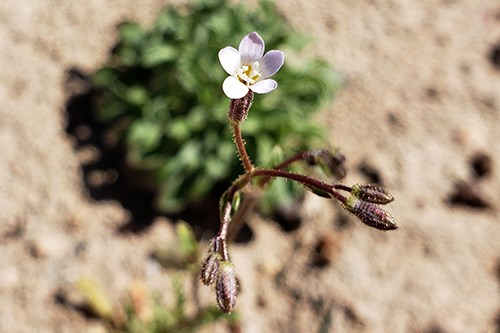
NPS/Hallie Larsen
Eyed Gilia ( Gilia ophthalmoides ) is a member of the Phlox Family with the typical five- petalled trumpet flowers, slender stem, and small basal rosette of leaves. The flowers are tiny, usually pale purple, but can range to white or pink. This is a very pretty plant, but is so small it can be easily missed. Look close and you might see tiny glandular hairs with round caps that make the stem sticky and smell nice.
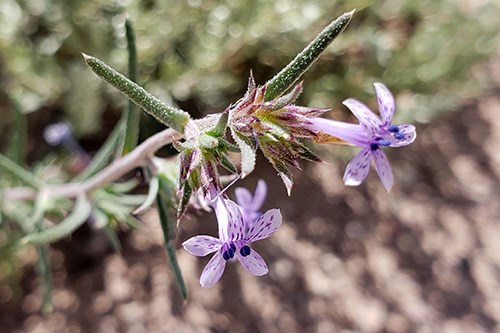
NPS/Hallie Larsen
Manyflowered Ipomopsis ( Ipomopsis multiflora ) is a small perennial with stems branching from the bottom. The leaves on the upper stems are small and linear while the lower are lobed. The purple freckled trumpet flowers gather in somewhat one-sided racemes on side branches.
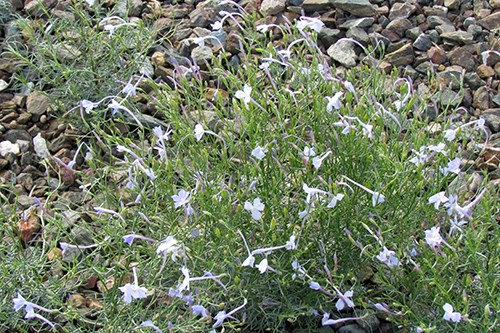
NPS/Hallie Larsen
Pale blue trumpets (Ipomopsis longiflora) have a descriptive name as the flowers are trumpet shaped, but they can be blue to purple. The leaves and stems are very slender making the many flowers appear to hover over the ground.
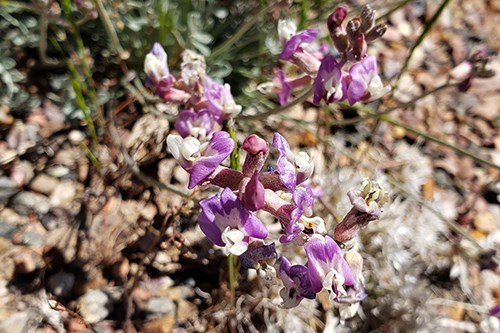
NPS/Hallie Larsen
Torrey's Vetch ( Astragalus calycosus var. scaposus ) forms a mound of compound leaves. Longer leafless stems encircle the mound, tipped by a cluster of lavender and white flowers. The pods are straight and reddish. The plant is covered with malpighian hairs which are short , sharp tipped, and attached with a short stem from their middle.
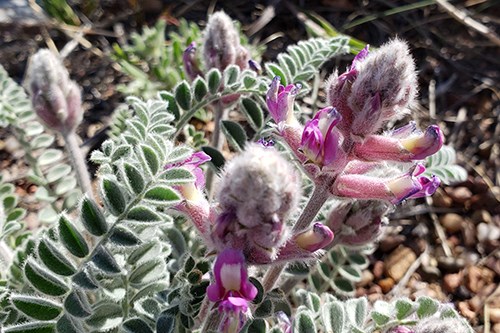
NPS/Hallie Larsen
Woolly Locoweed ( Astragalus mollissimus ) is hairy all over, including the small sage-green leaves, the purple buds, and the balled up pods. The purple pea-like tubular flower's upper banner bends backward.
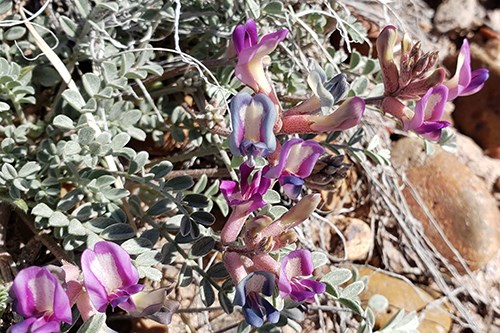
NPS/Hallie Larsen
Crescent Milkvetch ( Astragalus amphioxys ) has hairy leaves on often arching s tems. The magenta to purple flowers are cupped around a light center, eventually becoming hairy curved pods.
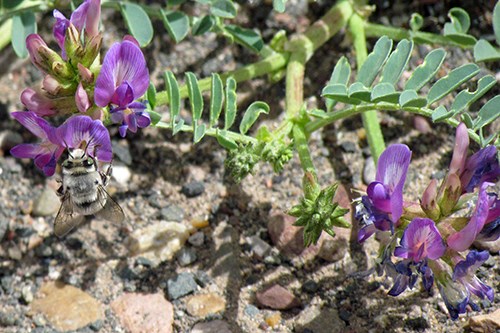
NPS/Hallie Larsen
Freckled Milkvetch (Astragalus lentiginosus) is one of the most variable plants in the western United States; this is one of the nearly forty varieties. This low, rounded vetch has compound leaves with oval leaflets, plump glabrous pods with a "beak" at one end, some small red freckling, and purple tubular flowers in pea-like racemes. Not much in the way of hairs or fuzz on the plant.
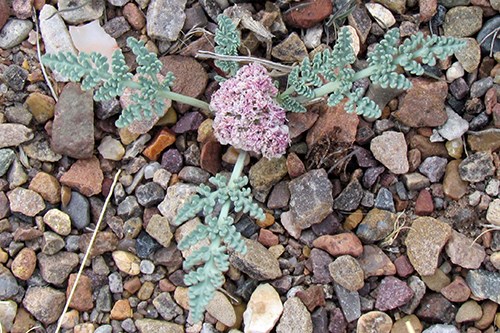
NPS/Hallie Larsen
As usual, biscuitroot aka purple spring parsley (Vesper bulbosus, syn. Cymopterus bulbosus) is the first flower to bloom. This low-grower likes gravely area so you are likely to see them around the petrified logs. What's better than fossil trees and fresh flowers? Biscuitroot is a member of Apiaceae (Parsley Family). It has a staunch pithy taproot to help it survive this semi-arid region and pale green lacy leaves, providing food above and below the ground for many species. Don't try to nibble something in the park if you aren't an expert.
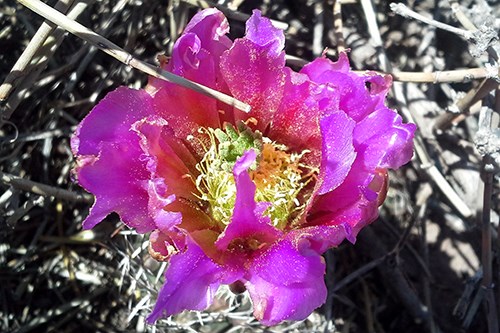
NPS/Hallie Larsen
This Pink-Flower Hedgehog Cactus (Echinocereus fendleri) has had a rough year. The mature stems are turning maroon and slumping. A new stem is forming under the blossoms. The silky magenta petals are dusted with abundant pollen. The loose clumps can have up to twenty stems, while this one had five, two of which have died and fallen off the cliff. Each areole has 4-12 mostly straight spines, some of the central ones tending to be darker with lighter radial ones.
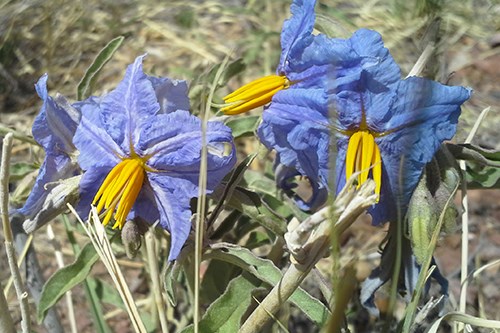
NPS/Hallie Larsen
Silver-leafed Nightshade (Solanum elaeagnifolium) is a common perennial in the park, showy with its normally purple starfish-shaped flower and long, wavy edged silver leaves with some spines underneath. They often grow in large groups. Eventually the flower turns into a golden round fruit. They have the typical large yellow stamen. While most are purple, there are white, the forma albiflorum.
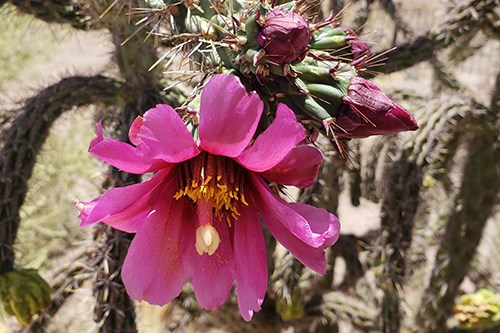
NPS/Hallie Larsen
Walking Stick Cholla (Cylindropuntia spinosior) is the tallest of the branched chollas in the park. It easily spreads through pups, although the branches are firmly attached. The flowers are magenta with yellow centers, becoming yellow fruit that linger. It is a good food for animals in the winter.
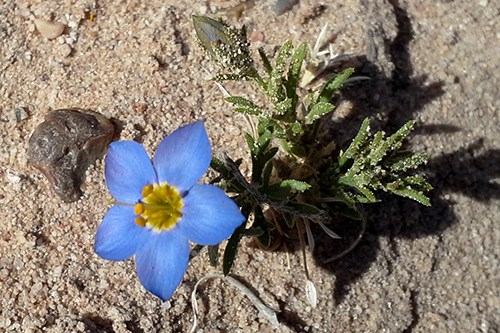
NPS/Hallie Larsen
Bluebowls (Giliastrum acerosum) are very small plants; sometimes the cobalt blue to purple flower is larger than the rest of the perennial. The base tends to be woody with small glandular leaves with needle-like lobes. The richly colored flowers have yellow throats. They tend to be in sandy and gravelly areas.
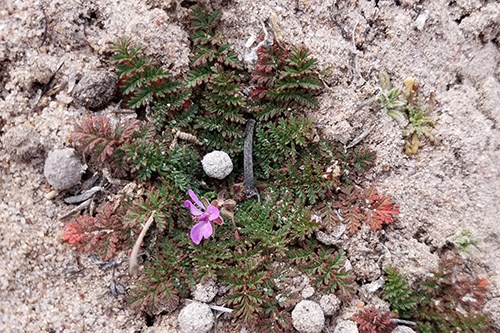
Dorenda Walters, volunteer
Redstem Stork's Bill ( Erodium cicutarium ) is the first bloom found this year! Sadly it is a non-native , but a dainty, pretty little thing. The highly divided leaves are red, burgundy and green forming a basal rosette, background for the violet flowers. The seedhead looks like the titular stork's bill, the scourge of bare feet everywhere.
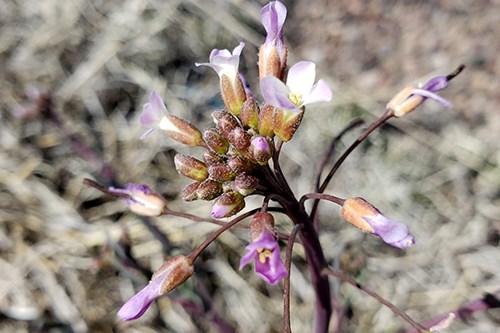
NPS/Hallie Larsen
Fendler's Rockcress ( Boechera fendleri ) is another member of the Mustard Family ( Brassicaceae ). The mostly basal leaves and long, slender stem make this one difficult to spot, but the white and purple four- petaled flowers make an attractive cluster on top. Look close at the leaves and you will find tiny forked hairs.
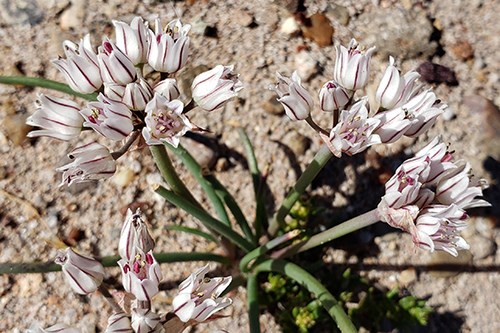
NPS/Hallie Larsen
Large- petaled Onion (Allium macropetalum ) has the typical hollow tubular leaves and the rounded cluster of bell flowers. The flowers are pink to white with a maroon stripe. The net-like pattern of fibers over the bulb help identify the species.

NPS/Hallie Larsen
Notch-leaf Scorpionweed (Phacelia crenulata ) form large purple swaths on south-facing hillsides. The common name is due to the curling cyme of purple flowers, like a scorpion's tail.
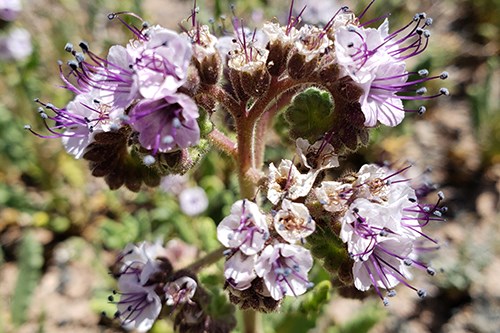
NPS/Hallie Larsen
Gypsum Phacelia (Phacelia integrifolia var. integrifolia ) is another species of the Phacelia genus. The flowers tend to be a light lavender than P . crenulata with blue anthers. The leaves are noticeably less notched.
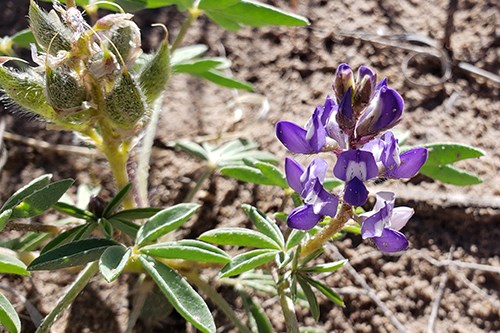
NPS/Hallie Larsen
Another legume, the tiny pea-flowers of Dwarf Lupine ( Lupinus pusillus ) become fuzzy pods. Like all legumes, lupine help fix nitrogen in the soil. Unlike many legumes, the fuzzy compound leaves of lupine are palmate. The bilateral flowers are blue to purple and white. This is a small, annual lupine that prefers sandy soils.

NPS/Hallie Larsen
Bare-Stem Larkspur ( Delphinium scaposum ) can become dramatic spikes of deep blue flowers. The hue actually can range from a light blue through nearly a purple blue. The basal leaves are scalloped. The bilateral flowers consist of five blue sepals, the top one having the large spur. There are four smaller petals, the top two having spurs that sit within the larger one. The lower petals have hairs that aid in pollination.
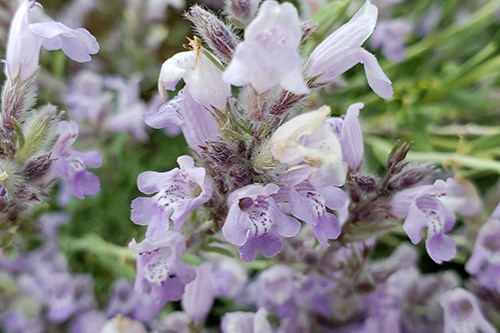
NPS/Hallie Larsen
Hoary Rosemary Mint ( Poliomintha incana ) has very hairy buds and sometimes stems and leaves, making the shrub look frosty. The white and lavender tubular flowers can seem deeper hued due to the dark calyxes.
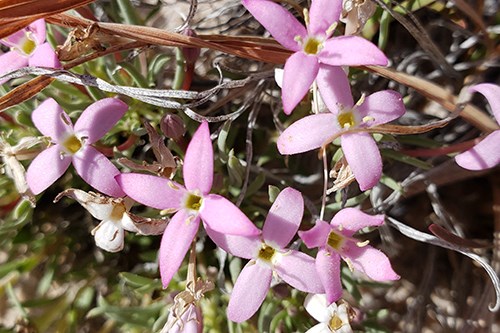
NPS/Hallie Larsen
Red B luet ( Houstonia rubra ) is a perennial herb with a woody taproot. The four- petalled , salviform flowers range from white, through pink, rose, to purple. The short, narrow leaves form densely packed clumps.
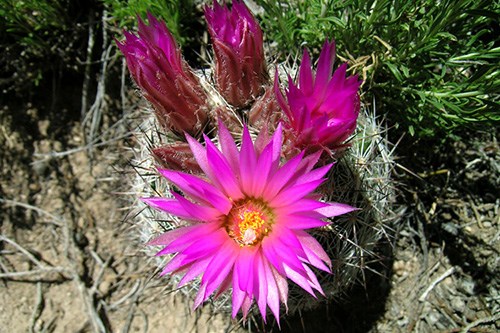
NPS/Hallie Larsen
Spinystar ( Escobaria vivipara ) is a small round cactus that can form mounds. The spines form beautiful starbursts, spines radiating from a central point. The flowers are a deep rose with narrow pointed petals.
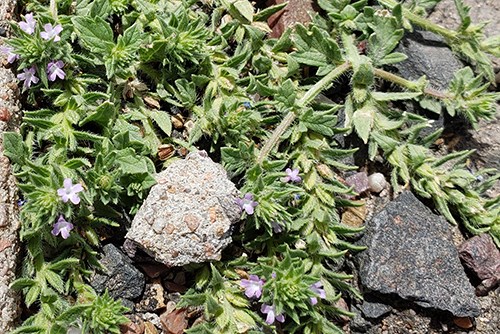
NPS/Hallie Larsen
Bigbract Verbena ( Verbena bracteata ) is a small sprawling plant. The hairy stems form a growing mat with lobed hairy leaves. The spike inflorescence is dense with pointed, leaf-like bracts, providing a dark green backdrop for the tiny pale purple trumpet flowers.
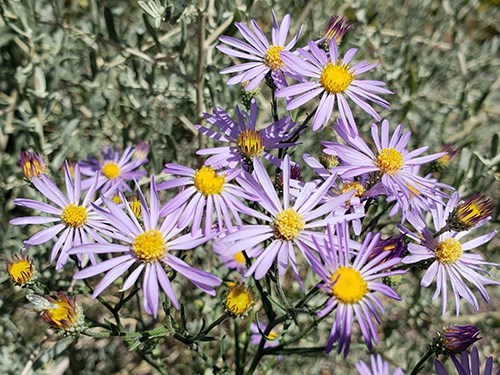
NPS/Hallie Larsen
Hoary Aster ( Dieteria canescens ) Dieteria species are very similar and difficult to tell apart. They all appear in late summer and bloom into the fall. All have lovely purple daisy-like flowers with yellow centers (i.e. purple ray flowers and yellow disc flowers). They have airy green foliage. The phyllaries are the parts to look for differences, like these that are straw colored with green tips that don't spread much .
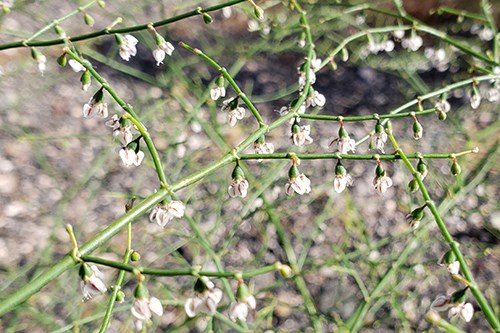
NPS/Hallie Larsen
Hooker's Buckwheat ( Eriogonum hookeri ) can blend into the background due to the dainty stems and broad umbrella of branches. The flowers (on very short peducles ) dangle beneath, white to pink with a dark vein on each tepal , turning rust as they age. The spoon-shaped leaves are hairy, often drying out when the flowers appear.
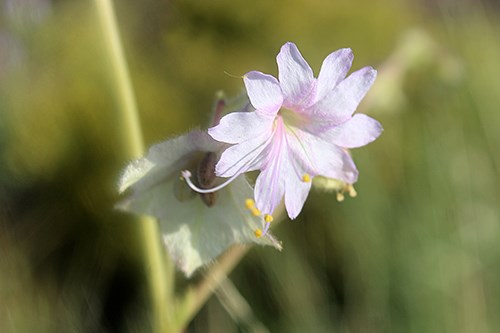
NPS/Hallie Larsen
Narrowleaf Four O'Clock (Mirabilis linearis var. linearis) is a legume, belonging to the Fabaceae family. The tiny flowers are in a rounded terminal cluster of white. The fountain-shaped plant often disappears into the bunch grass with its long stems and tiny compound leaves.
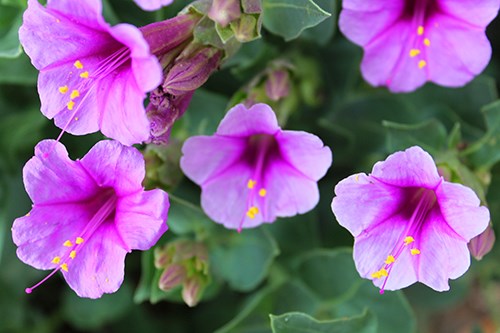
NPS/Hallie Larsen
Showy Four O'Clocks (Mirabilis multiflora ) can be spectacular, sprawling mounds of rounded green leaves covered with magenta trumpets. Nyctaginaceae (Four O'Clock Family) flowers have no petals. The flowers are actually fused sepals with curling stamens and pistil projecting outward.
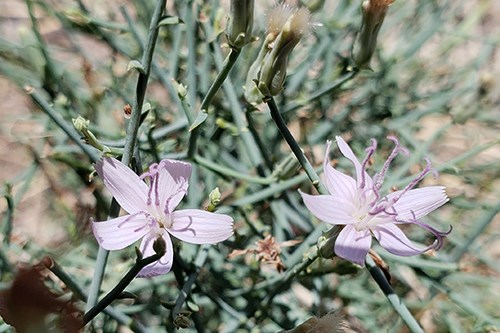
NPS/Hallie Larsen
Brownplume Wirelettuce (Stephanomeria pauciflora) is a small perennial with many blue-green branches, few leaves, and lavender flowers with toothed corollas. The fluffy pappi are tannish.
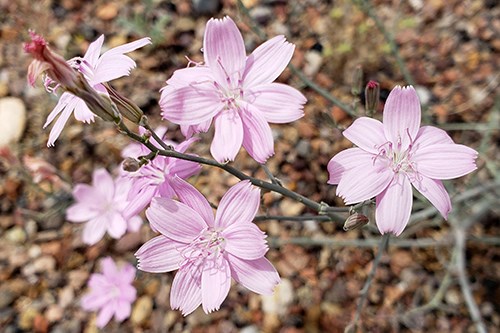
NPS/Hallie Larsen
Rush Skeletonplant ( Lygodesmia juncea ) is tall with airy nearly leafless blue-green stems. The blooms are pale lavender to pink ray flowers that become fluffy seedheads .
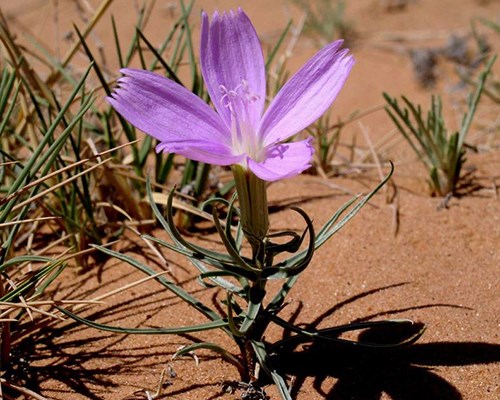
NPS/Hallie Larsen
Arizona Rushpink ( Lygodesmia arizonica ) tends to be the shortest of this genus, with narrow curling leaves. The pale lavender flowers become tan fluffy seedheads .
rodriguezhamay1951.blogspot.com
Source: https://www.nps.gov/pefo/learn/nature/pink-purple-blue-wildflower-guide.htm
0 Response to "The Pink and Blue Species Below Form a Violet"
Post a Comment